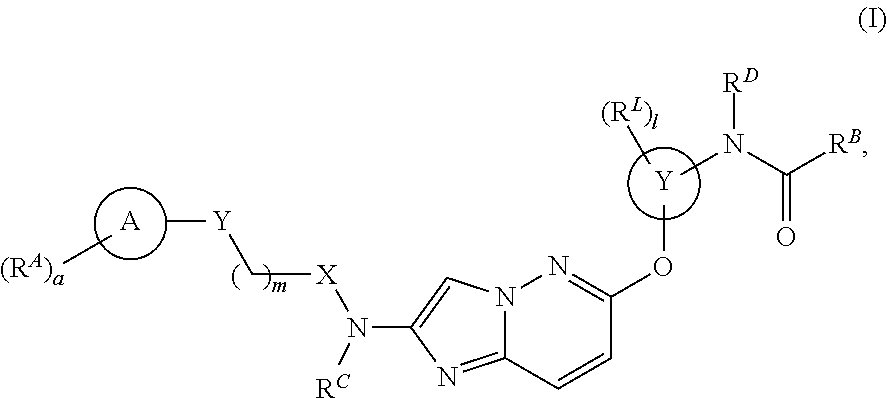Novel Compounds and Uses Thereof
a technology of compounds and compounds, applied in the field of new compounds and uses thereof, can solve the problems of irreversible vision loss in developed countries, achieve the effects of avoiding mucus clearance mechanisms, quick elimination, and effectively delivering the intended therapeutic
- Summary
- Abstract
- Description
- Claims
- Application Information
AI Technical Summary
Benefits of technology
Problems solved by technology
Method used
Image
Examples
example 1
Preparation of Compound I-1
[0639]
[0640]N-(5-(2-Aminoimidazo[1,2-b]pyridazin-6-yloxy)-2-methylphenyl)-1,3-dimethyl-1H-pyrazole-5-carboxamide (compound 6, 189 mg, 0.5 mmol) was dissolved in dichloromethane. 2-(Oxetan-3-yl)acetic acid (87 mg, 0.75 mmol) was added followed by 1-ethyl-3-(3-dimethylaminopropyl)carbodiimide (EDCI, 155 mg, 1.0 mmol) and 4-dimethylaminopyridine (DMAP, 5 mg). The resulting mixture was stirred for 3 hours, diluted with ethyl acetate (25 mL), and washed with saturated sodium bicarbonate (10 mL). The organic phase was separated, dried with anhydrous magnesium sulfate, and evaporated. The resulting residue was purified by flash chromatography eluting with a gradient from ethyl acetate to ethyl acetate-methanol (70:30). The fractions were concentrated, and the resulting residue was suspended in dichloromethane (1 mL) and diethyl ether (20 mL) was added. The resulting precipitate was filtered and dried in high vacuum to yield compound I-1 as a white solid (82 mg). ...
example 2
Preparation of Compound I-2
[0641]
[0642]N-(5-(2-Aminoimidazo[1,2-b]pyridazin-6-yloxy)-2-methylphenyl)-1,3-dimethyl-1H-pyrazole-5-carboxamide (compound 6, 189 mg, 0.5 mmol) was dissolved in tetrahydrofuran. Triethylamine (0.5 mL, 3.5 mmol) was added followed by chloroacetyl chloride (96 mg, 0.85 mmol), then the resulting mixture was stirred for 1 hour to generate intermediate 12. (S)—N,N-dimethylpyrrolidin-3-amine (171 mg, 1.5 mmol) was added. The resulting mixture was heated to 60° C. for 2 hours. The volatiles were evaporated, and the residue was dissolved in dichloromethane (25 mL) and washed with saturated sodium bicarbonate (10 mL). The organic phase was directly purified by flash chromatography eluted with a gradient from dichloromethane to dichloromethane-methanol-triethylamine (80:10:10). The fractions were concentrated, leaving a yellow foam (200 mg). Further purification was performed using reverse phase chromatography (8-gram C18 column, gradient from 5:95 water-acetonitril...
example 3
Preparation of Compound I-3
[0643]
[0644]Compound I-3 was prepared in the same manner as compound I-2 except that (R)—N,N-dimethylpyrrolidin-3-amine was used instead of (S)—N,N-dimethylpyrrolidin-3-amine. Compound I-3 was obtained as a yellow solid (32 mg). MS: m / z 532.3 (M+1) (positive ionization mode). 1H NMR: (DMSO-d6): 10.35 (s, 1H), 9.79 (s, 1H), 8.14-7.79 (m, 2H), 7.37-7.26 (m, 2H), 7.12-7.02 (m, 2H). 6.80 (s, 1H), 3.96 (s, 3H), 3.42-3.16 (m, 2H), 2.79-2.60 (m, 4H), 2.59-2.53 (m, 1H), 2.48-2.40 (m, 1H), 2.34 (s, 3H), 2.17 (s, 3H), 2.09 (s, 3H), 1.89-1.80 (m, 1H), 1.66-1.58 (m, 1H).
PUM
| Property | Measurement | Unit |
|---|---|---|
| RH | aaaaa | aaaaa |
Abstract
Description
Claims
Application Information
 Login to View More
Login to View More - R&D
- Intellectual Property
- Life Sciences
- Materials
- Tech Scout
- Unparalleled Data Quality
- Higher Quality Content
- 60% Fewer Hallucinations
Browse by: Latest US Patents, China's latest patents, Technical Efficacy Thesaurus, Application Domain, Technology Topic, Popular Technical Reports.
© 2025 PatSnap. All rights reserved.Legal|Privacy policy|Modern Slavery Act Transparency Statement|Sitemap|About US| Contact US: help@patsnap.com



